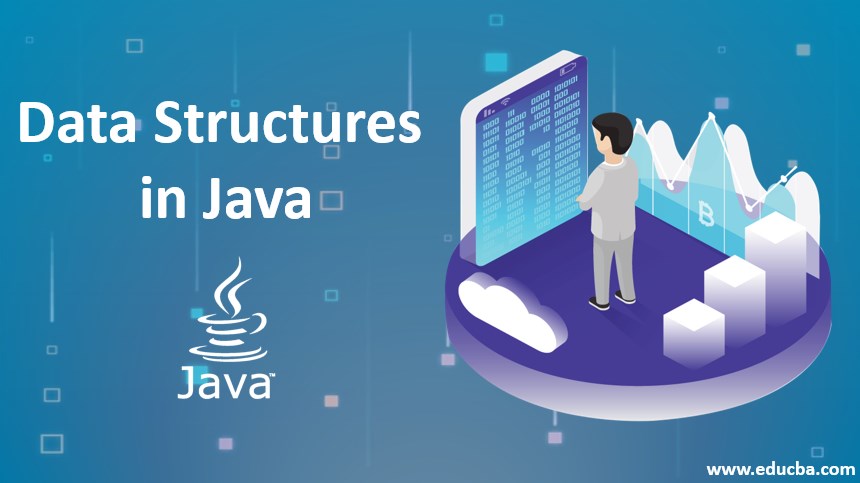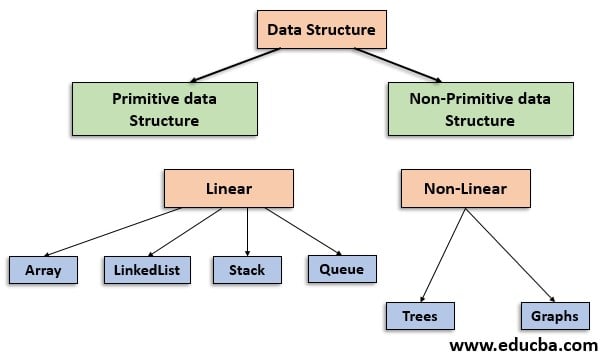Updated April 6, 2023

Introduction to Data Structures in Java
Data structure can be defined as a collection of different data elements. Data structure in Java is a way of storing and organizing data and information in a computer system so that the stored data can be retrieved and utilized efficiently. Therefore using appropriate data structure can play a vital role in increasing the performance of an application.
Types of Data Structures in Java
Java API provides built-in support for common data structures which are of two types:
1. Primitive Data Structures
These are basic data structures and are used only for basic operations. Integers, Floating, Numbers, Strings, Characters, Pointers fall in this category data structures.
2. Non-Primitive Data Structures
These are complex data structures and are meant to perform complex operations related to data. Non-Primitive data structures are derived from primitive data structures. Non-primitive data structures can be broadly divided into two sub-categories, linear data structures, and non-linear data structures. Array, Linked List, Stack, Queue fall in the category of linear data structures whereas trees and graphs fall in the non-linear data structure category. Now we will explain each data structure in detail:
3. Array
An array can be defined as a collection of homogenous elements. An array is a fixed-sized static data structure. Each individual item of an array is called an element. An array in java can have any valid data type available in a java programming language. All elements in the array are identified by the same variable name but each element has a unique index through which its value can be stored or retrieved. An array is java can be one-dimensional, two-dimensional, or multi-dimensional. Individual elements of an array having variable name arr and having size 10 are as follows: arr [0], arr [1], arr [2], arr [3]……………………, arr [9].
4. Linked List
Linked list maintains a list in memory and is a collection of elements called nodes. This is a dynamic data structure that is its size is not fixed. Linked list has a head node and a tail node and each available node in a linked list contain a pointer to its adjacent node. It is to be noted that nodes of a linked list are present at non-contiguous locations in memory.
5. Stack
It is a dynamic data structure in which insertion of a new element and deletion of an existing element is allowed to be done only at one end. It follows the Last in First out Strategy (LIFO). The stack can be implemented in most programming languages and hence it is considered as an abstract data type (ADT).
6. Queue
This is also an abstract data type like stack and can be implemented in most programming languages. This is a dynamic data structure that follows the first in first out (FIFO) strategy which means an element that is inserted first will be removed first. The queue has two ends named front end and rear ends. In a queue, insertion can be done at the rear end and deletion can be done at the front end.
7. Tree
Tree data structure is based on the parent-child relationship. These are multilevel data structures made up of a collection of elements called nodes. Nodes in a tree data structure maintain hierarchical relationships among them. The topmost node of a tree is called the root node and the bottommost nodes are called the leaf nodes. Each node in a tree contains pointers to adjacent nodes. Each available node in a tree can have more than one child with the exception being the leaf node whereas each node can have at most one parent node except the root node which is the only parent of all nodes available in Tree.
8. Graphs
This data structure contains elements based on pictorial representation. Each individual element present in the graph is represented by a vertex. Elements in a graph data structure are connected to each other via links called edges. The major difference between graph and tree is that the former data structure can contain a cycle whereas later cannot contain a cycle.
Framework
The whole data structure framework can be summarized with the help of the below flow chart:

Advantages of Data Structures in Java
The following are the main advantages of using data structures:
- Efficiency
- Reusability
- Abstraction
- Fast Processing Speed
- Easy Searching
- Serving multiple requests with Ease.
Conclusion
From the above article, we have a clear introduction to data structures in java. Using data structures make complex task easy in a system. Also, we have seen different advantages of using data structures.
Recommended Article
This is a guide to the Data Structures in Java. Here we discuss types of Data Structures in Java and their framework along with advantages, disadvantages. You can also go through our suggested articles to learn more –

